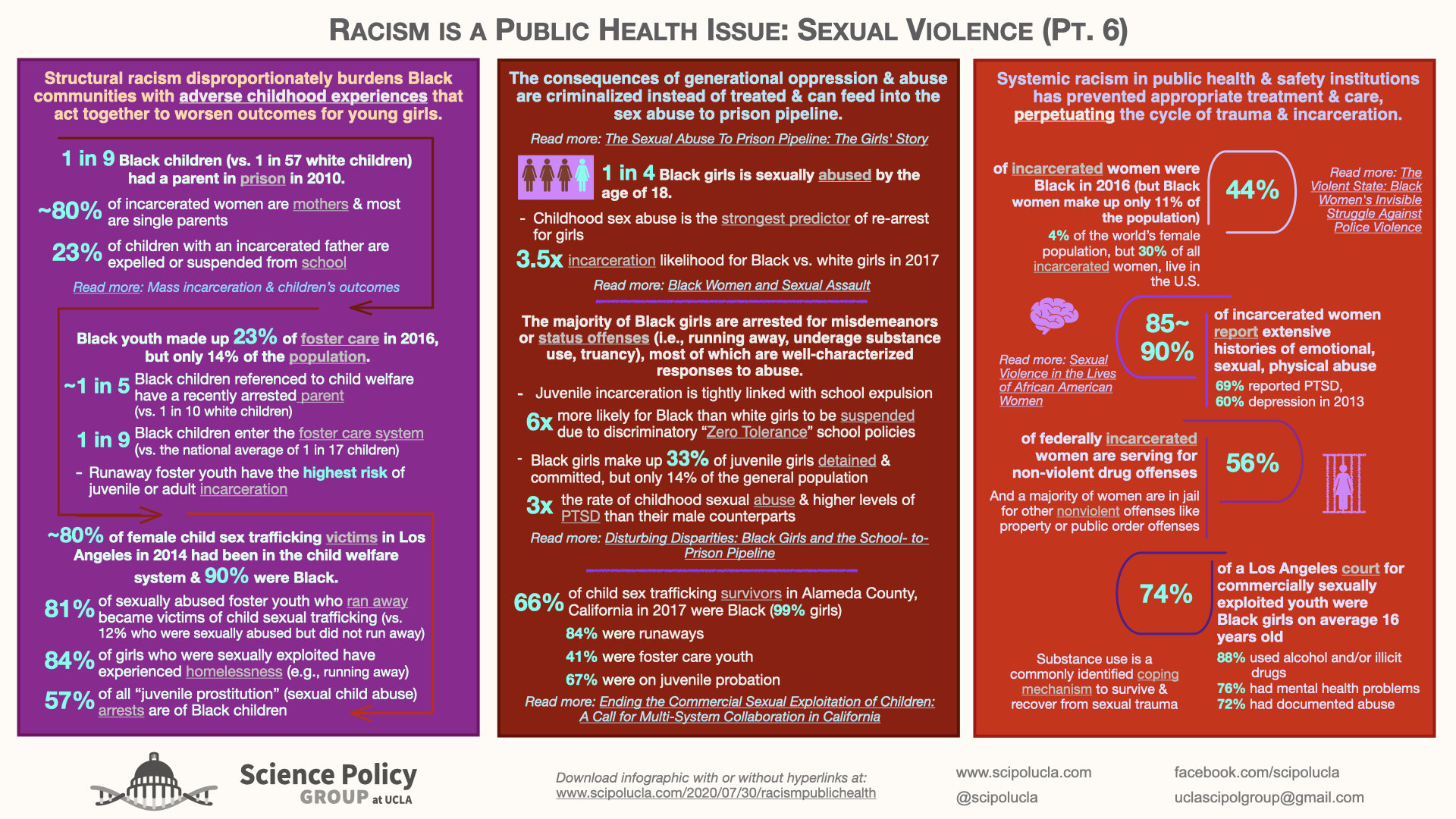Infographic Series
Racism is a Public Health Issue
To align our efforts to the current civil rights movement, we have compiled an infographic series titled “Racism is a Public Health Issue.”
Working to become anti-racist requires that we research and acknowledge the persistence and gravity of structural racism, including within the sciences. We hope that this series will help to serve as a primer on some prevalent yet severely under-addressed issues.
This is by no means a comprehensive resource, and we appreciate productive feedback as we all strive to meaningfully educate ourselves.
Download infographics with hyperlinks intact,
or browse images (without intact hyperlinks) below!
Racism infects all areas of life for Black Americans & is structurally embedded in crucial facets of our society.
Racism: “an organized social system in which the dominant racial group, based on an ideology of inferiority, categorizes & ranks people into social groups (i.e., “races”) & uses its power to devalue, disempower, & differentially allocate valued societal resources & opportunities to groups defined as inferior.” (read more)
Part 2: School & education
White school districts average 23 billion more in annual funding than nonwhite districts. Racially-skewed resource allocation among school districts influences health & quality of education for Black students. Black students are 40% more likely to be chronically absent. More than 14 million students are in schools with police officers but no counselor, nurse, psychologist, or social worker. The imbalance between resources dedicated to the punishment rather than the well-being of students is accompanied by over disciplining & criminalization of Black students.
Part 4: Health Care Quality
Levels of physician explicit & implicit bias impact medical decisions. Implicit & explicit biases become more prevalent under time pressure, cognitive overload, & fatigue, which are common conditions for emergency doctors. Effects of cumulative stress on the body are worse for Black than white Americans.
Part 5: Sexual & Reproductive Health
Black women face unique & severe challenges to their sexual & reproductive health stemming from historical & current inequalities in healthcare and economic opportunities. These include threats related to maternal health, health insurance, incarceration, STI/STDs, sex education, and family planning, among others. These dangers are amplified for Black transgender women.
Part 6: SExual Violence
Structural racism disproportionately burdens Black communities with adverse childhood experiences that act together to worsen outcomes for young girls. The consequences of generational oppression & abuse are criminalized instead of treated & can feed into the sex abuse to prison pipeline. Systemic racism in public health & safety institutions have prevented appropriate treatment & care, perpetuating the cycle of trauma & incarceration.
Part 8: Environmental Racism & Land Uses
Many nonwhite communities lack access to fundamentals like clean air (see pt. 7) & water. This can be due to inadequate infrastructure and a lack of social & political capital. Institutional racism impacts decisions on the location of undesirable land uses & environmental hazards. Nonwhite communities, who typically don’t have the political representation or legal resources to oppose these hazardous sites & negligent regulations.
Part 9:
CLIMATE CHANGE, EXTREME WEATHER, & NATURAL DISASTERS
Due to centuries of discriminatory policies & structural marginalization, Black Americans are more likely to live in places most vulnerable to climate change & extreme weather. These same forces have led to the exclusion of nonwhite families from factors that lead to resilience in the face of disasters, like wealth, insurance, employment, and political & social capital. Nonwhite Americans are largely excluded from local & national disaster planning, have limited ability to advocate for resources (i.e., prevention & recovery), and a majority of donor money goes to white-led environmental groups.
CLIMATE CHANGE, INFRASTRUCTURE, & CURRENT ISSUES
Black Americans are less responsible for, but more concerned about, climate change. Changes in weather patterns & decreases in biodiversity caused by climate change also affect the emergence & spread of infectious diseases. The rise in prices of basic necessities (e.g., energy & water) caused by climate change (e.g., hurricane/flood damages) will disadvantage those who are already paying a higher percentage of their income to such necessities. Irrigation exacerbates drought conditions, water shortages, & pollution runoff (i.e., nitrous & phosphorus) that disproportionately affect communities of color. Greater than 1/6 of emergency forces fighting wildfires in 2018 in California were incarcerated & the majority were Black. Since most prisons are not prepared for natural disasters & extreme weather events, those incarcerated suffer dire consequences.























